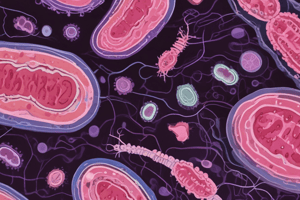Podcast
Questions and Answers
What is the consequence of NADPH depletion in the polyol pathway?
What is the consequence of NADPH depletion in the polyol pathway?
- Increased regeneration of glutathione
- Decreased levels of glutathione (correct)
- Increased production of glucose
- Decreased intracellular oxidative stress
Which tissue is NOT typically affected by the polyol pathway during hyperglycemia?
Which tissue is NOT typically affected by the polyol pathway during hyperglycemia?
- Kidney
- Heart muscle cells (correct)
- Red blood cells (RBCs)
- Nerves
What role do advanced glycation end products (AGEs) play in tissue injury?
What role do advanced glycation end products (AGEs) play in tissue injury?
- They increase the flexibility of tissues
- They promote nutrient absorption in the bloodstream
- They enhance the breakdown of clots
- They modify proteins and can induce oxidative stress (correct)
How does chronic hyperglycemia contribute to the formation of reactive oxygen species (ROS)?
How does chronic hyperglycemia contribute to the formation of reactive oxygen species (ROS)?
Which of the following describes a function of protein kinase C (PKC) in the context of high glucose levels?
Which of the following describes a function of protein kinase C (PKC) in the context of high glucose levels?
What effect does the accumulation of sorbitol in cells have?
What effect does the accumulation of sorbitol in cells have?
What is one of the key consequences of the thickening of the basement membrane due to AGEs?
What is one of the key consequences of the thickening of the basement membrane due to AGEs?
What process does hyperglycemia initiate that leads to the dysfunction of nitric oxide (NO)?
What process does hyperglycemia initiate that leads to the dysfunction of nitric oxide (NO)?
What is a potential result of the increased production of diacylglycerol (DAG) in cells due to high glucose levels?
What is a potential result of the increased production of diacylglycerol (DAG) in cells due to high glucose levels?
Which factor contributes to compromised perfusion of swollen red blood cells?
Which factor contributes to compromised perfusion of swollen red blood cells?
Flashcards are hidden until you start studying
Study Notes
Theories of Pathogenesis in Chronic Complications
- Understanding pathogenesis theories can clarify the basis for chronic complications in diabetes.
- Pharmacologic treatments targeting specific pathophysiological pathways are under investigation.
Polyol Pathway
- The polyol pathway serves as an alternative glucose metabolic route in insulin-independent tissues (kidneys, RBCs, blood vessels, eye lenses, nerves).
- Aldose reductase converts toxic aldehydes to inactive alcohols; in hyperglycemia, glucose is converted to sorbitol.
- This conversion requires NADPH, which is vital for glutathione regeneration; decreased NADPH leads to reduced glutathione and increased oxidative stress vulnerability.
- Sorbitol dehydrogenase converts sorbitol into fructose, raising intracellular osmotic pressure, attracting water, and causing cell injury.
- Diabetic complications such as visual alterations and cataracts are linked to these processes.
- Sorbitol disrupts ion pumps in nerves, damages Schwann cells, and impairs nerve conduction.
- Swelling of RBCs can lead to stiffness, compromising perfusion.
Formation of Advanced Glycation End (AGE) Products
- Advanced glycation end products (AGEs) form through non-reversible glucose binding to proteins, leading to tissue damage.
- Persistent hyperglycemia raises AGEs in collagen and proteins in RBCs, blood vessels, and interstitial tissues.
- AGEs and their receptor (RAGE) can inflict tissue injury, with impacts including:
- Modification of intracellular proteins affecting gene transcription.
- Cross-linking proteins, hindering normal function.
- Basement membrane thickening, obstructing nutrient and waste exchange, impairing blood flow.
- Increased blood vessel and nerve permeability.
- Stimulation of excessive cellular proliferation.
- Inducing oxidative stress, inflammation, and lipid oxidation.
- Inactivation of nitric oxide (NO), reducing vasodilation and endothelial function.
- Promotion of platelet adhesion and impaired clot breakdown.
Problems with Tissue Oxygenation
- Decreased oxygen delivery in small vessels contributes to various chronic complications.
- Defects in RBCs can lead to impaired oxygen release from hemoglobin.
- Chronic hyperglycemia elevates reactive oxygen species (ROS) production, which inflicts oxidative damage.
- Contributors to increased ROS in hyperglycemia include AGEs, nitric oxide dysfunction, and NADPH depletion.
- ROS damage both small and large vessels, leading to atherogenesis, cardiovascular diseases, nephropathy, and neuropathy.
Protein Kinase C (PKC)
- Elevated intracellular glucose results in increased production of diacylglycerol (DAG), activating protein kinase C (PKC).
- PKC plays a crucial role in regulating vascular functions such as permeability and blood flow.
Studying That Suits You
Use AI to generate personalized quizzes and flashcards to suit your learning preferences.




